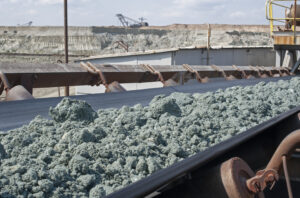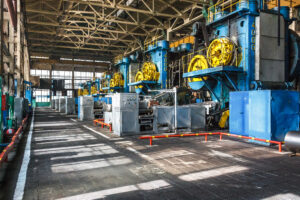Australian Critical Minerals (ASX:ACM) gets set in Llamaland, Peru!
![]() Stuart Roberts, June 17, 2025
Stuart Roberts, June 17, 2025
Let’s take a look at Australian Critical Minerals (ASX:ACM). And we’d like to do something we don’t normally do when looking at junior resources stocks, but share with you how this stock came across our radar as one of interest. It all began with noticing ACM’s jurisdiction, which we did last October at the International Mining and Resources Conference and Expo in Sydney.
At that annual meeting – and at other similar conferences too – a lot of mining-friendly jurisdictions such as Quebec and Victoria, or wannabe mining-friendly jurisdictions such as Saudi Arabia, have their own booths to market themselves as investment destinations.
At the 2024 Sydney IMARC one of the largest such booths was the one from Peru. Peru is a major Latin American country with a population of 34 million and is the world’s third-largest copper producer. People had been telling me that Peru had recently gone up a notch in terms of the ease with which miners and explorers could do business, and when we saw that Peru’s then Minister of Energy and Mines, Romulo Mucho, was in attendance in Sydney we made a note to pay more attention to that country as a destination.
Rich geology, not so rich politics
The thing to understand about Peru is that it’s mineral endowment is truly enormous thanks to geology, but underdeveloped thanks to politics. There’s a heck of a lot of not just porphyry copper-gold (with an occasional dash of molybdenum) but also IOCG copper and epithermal gold, both at all levels of sulphidation. The four main intrusion-related mineral belts in Peru extend pretty much the north-to-south length of the country for more than 2,000 km.
A Miocene-age belt gave Peru the massive Yanacocha gold deposits in the north with their 40 million ounces, and the Antamina copper-zinc mine partly owned by BHP, which produced in excess of 400,000 tonnes of copper in 2024. Older Eocene and Paleocene belts either size of this belt also contribute some major copper mines in the south such as Freeport’s Cerro Verde and MMG’s Las Bambas.
There could be a lot more mines like these. Except that occasionally Peru goes through periods of political and economic instability which tends to deter new investment. The reason Peru is making such a push at meetings like IMARC is that after Dina Boluarte replaced the left-leaning Pedro Castillo as President in 2022 the country needed to woo those investors back.
Watch our recent interview with CEO Dean de Largie!
Buenos días, Peru
We were reminded of Peru’s recent promotional efforts last week when we were interviewing Dean de Largie, who is CEO of Australian Critical Minerals, ASX: ACM. Dean and ACM have just picked up a number of gold and copper projects in Peru including one with a small non-JORC resource estimate.
Dean is an Australian geologist who has spent a lot of time in Peru since 1996 and is fluent in Spanish. We asked him what attracted him to the country, and his reply confirmed what we’d started learning: Peru has been and always will be a mining jurisdiction with a system miners and explorers can usually work with. So, if you do the contrarian thing and go there when there’s a bit of economic or political instability you’re likely to pick up something interesting.
ACM’s new flagship is the Blanca Gold-Silver Project, in Peru’s northern Lambayeque Region. Not far from Blanca is Canariaco, a porphyry copper deposit held by Alta Copper (TSX: ATCU), which has recently attracted Australia’s FMG as a 25% shareholder, while Rio Tinto has another copper porphyry in the neighbourhood called La Granja.
Historic drilling at Blanca came in with exciting numbers like 9.5 metres at 11.27 g/t gold and 4 metres at 3.97 g/t gold, and that allowed a previous operator to estimate a resource estimate of 190,000 ounces of gold and 945,000 ounces silver where the ore grades were 2.2 g/t gold-equivalent.
Blanca covers a low sulphidation epithermal quartz vein system where the main vein of interest, called Cruz, has a strike length of about three kilometres as suggested by trenching and rock sampling. Only around 500 metres of that has been drilled, with drilling that didn’t even get beyond 90 metres depth.
ACM now plans a 3,500 metre drill program to upgrade the Blanca resource to a Measured and Indicated JORC compliant resource, as well as further explore the potential of the Cruz vein.
Some great neighbours
Blanca alone is enough to attract new investor interest in a junior like ACM given what gold’s been doing, but there’s more where that came from.
The Riqueza Copper-Silver Project down in southern Peru’s Huancavelica Region, inland from the port city of Callao, is interesting because the of the grades that have turned up in the rock chip samples – think 8.7% copper, 2,238 g/t Ag, 31% zinc and 35% lead at the max – but also because the geophysical work has picked a few conductors that correlate with what’s in those samples.
There’s now six targets that ACM will test with a 3,420 metre diamond drill program. In this mining district ACM’s neighbours will be Anglo American, Teck and BHP, among others, so if something shows up, there’s likely to be farm-in interest.
Not far away from Riqueza is another ACM project called Cerro Rayas that covers some old zinc-lead-silver workings where the rock chip samples, grading over 40% combined lead and zinc, suggest the workings are still worth looking at.
And then there’s Dean’s favourite project
And then there’s the Flint Gold Project, in La Libertad Region in the north. This is the one that has De Largie and ACM very excited because the trace element geochemical signature and the IP geophysics is indicative of an intact high sulphidation system extending from near surface in the north and plunging gently to the south. It is located adjacent to a copper deposit called San Juan at a higher topographic level, which is owned by a Mexican conglomerate called Grupo BAL.
De Largie worked on the northern half when it was within an ASX-listed company called Promesa, which eventually became PVW Resources (ASX: PVW). De Largie subsequently bought the project, expanded the known size of the hydrothermal system and tenure.
The new name Flint represents the expanded project area. De Largie reckons Flint’s high sulphidation system, and the corresponding geophysics, makes this project look like the Salares Norte field which Gold Fields has in the Atacama region of northern Chile, which now has an endowment of in excess of 3 million ounces.
Conclusion
ACM just raised $1,000,000 at 5.5 cents per share to move this attractive suite of projects forward. The news flow should be ample to keep those investors interested, with activity in all three projects and drilling at Flint to commence shortly. Drilling at Blanca will start late this year. With multiple shots on goal and a resource to build on, this is a story that is ahora (today), not manana (tomorrow).
What are the Best ASX Resources Stocks to invest in right now?
Check our buy/sell tips
Blog Categories
Get Our Top 5 ASX Stocks for FY26
Recent Posts
Paladin Energy (ASX:PDN) Jumps 10% as Revenue Surges Past A$177M
Paladin Energy (ASX: PDN) Surges as Uranium Producer Era Begins Paladin Energy (ASX: PDN) gave investors reason to cheer as…
Metal Powder Works (ASX: MPW) Falls 14% — Growing Pains or a Setup for Long-Term Gains?
Metal Powder Works Plunges 14% as Growth Story Faces Reality Check Metal Powder Works (ASX: MPW) took a sharp fall…
Blinklab (ASX:BB1): Is this exciting company the next ResApp?
Blinklab (ASX:BB1) is the answer to the question of how you could help children with autism – a response that…




